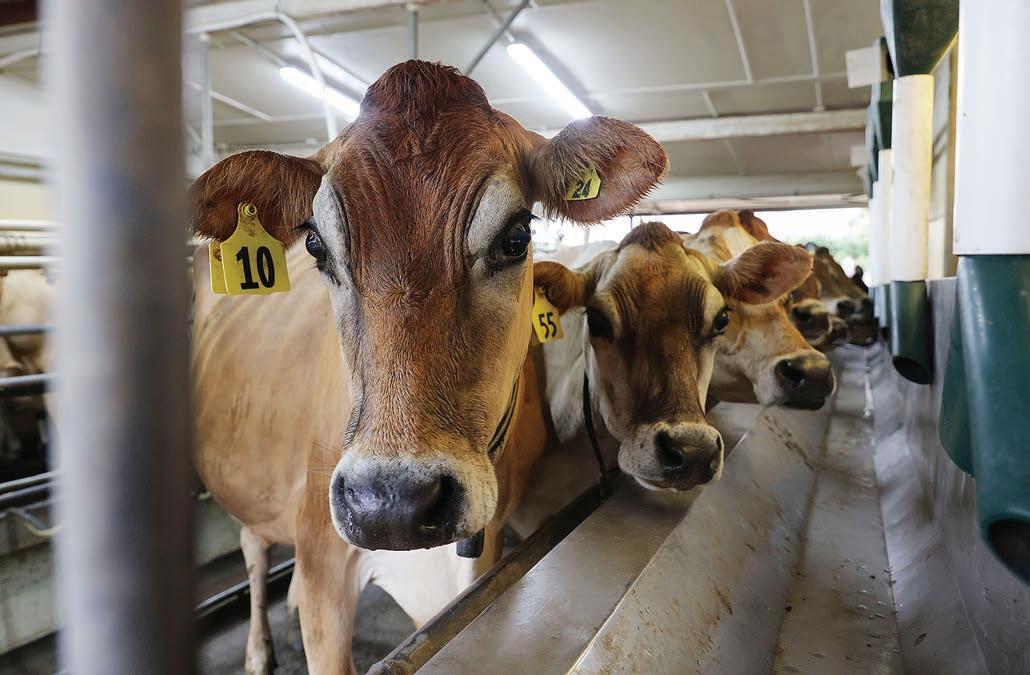
3 minute read
Old man Donald had a farm
by AgriHQ
A dairy farm on the outskirts of New Zealand’s largest city is also an outdoor classroom for future generations of farmers.
By Gerald Piddock
At Donald’s Farm students learn in the field about dairy’s ‘grass to glass’ story as well as how the industry tries to mitigate its environmental footprint.
Running Donald’s Farm on the edge of New Zealand’s largest city allows an Auckland farmer to operate one of the country’s most unusual dairy businesses.
Owned by NZ Young Farmers (NZYF), the 63ha effective farm in Whitford is managed by Sam Waugh. It acts as both a commercial dairy farm and as an educational hub for Auckland schoolchildren to visit in order to learn about the primary sector.
spent most of my time after school in Canterbury. I never thought I would be living, let alone farming, in Auckland. It was never on my radar.
“Farming here has its challenges but it’s quite a unique location where you are just far enough away that you still feel like you are not in the city but we are close enough that it’s very relatable for the urban population when they do come out.”
He has a view of arguably Auckland’s most recognisable landmark out of his living room window.
“It’s quite interesting waking up every day and looking at the Sky Tower as a farmer.”
It’s also given cause for him to reflect on the so-called urban-rural divide between farmers and the urban population.
For Waugh, it means combining conventional day-to-day farming with a de facto teacher’s role.
It’s a challenge he relishes.
“We don’t know of any other farm in New Zealand that’s trying to do what we do. Being so close to the city and being able to work alongside urban schools to bring kids out to a whole other world is quite a unique opportunity,” he says.
It gives him, wife Liana and son Albie an insight into living and operating a dairy farm on Auckland’s fringe that few have.
“I grew up in Manawatū and then
“You don’t know what you don’t know and the people visiting the farm have very rarely had the opportunity to talk to a farmer, let alone come out to a farm.
“Their knowledge isn’t there because they don’t know what they don’t know. Sometimes in the rural sector, we see the divide as a problem. I don’t see it as a divide, it’s a misunderstanding or a lack of knowledge.”
That misunderstanding also goes both ways and he questions whether farmers truly understand the needs of urban populations.
“For me, one of the things I really like about this job is being able to walk the line between the two and help bridge that understanding and knowledge.”
The 74ha farm has 11ha of retired areas and native bush, milking a 120-cow selfcontained herd of mostly Jersey cows along with a small number of milking shorthorn, a legacy of the late Donald Pearson, the farm’s former owner.
He bequeathed the farm to New
Continued page 10
Farm Facts
• Farm owners: New Zealand Young
Farmers
• Manager: Sam Waugh
• Location: Whitford (South Auckland)
• Farm size: 74ha (63ha effective)
• Cows: 120
Jersey/milking
Shorthorn
• Production: 20212022: 36,942kg MS
• Production target: 2022-2023 37,000kg
MS
Zealand Young Farmers in 2018.
The generosity of Pearson’s gesture, given the land value of the farm because of its location, is not lost on Waugh.
He says Pearson was approached numerous times over the years by developers who wanted to turn the farm into lifestyle blocks.
“He was adamant that it’s not what he wanted and it’s very much a strong part of our identity and how we operate.”
Pearson knew that the understanding and knowledge of farming and how food is produced was diminishing within NZ’s urban population. He believed his farm could be used to help turn this trend around.
“It was Donald’s wish that the farm remain as an operational farm and that it be used to connect communities with farming,” Waugh says.
It’s a commercial farm, but its focus is split between profitability and education, with the farm used as an outdoor classroom for schoolchildren.

“His focus for the farm was connecting communities with farming and that’s what we’re starting to develop,” Waugh says.
“What we would like to do long term is to have around 5000 students a year on the farm and connect with students multiple times during their schooling, from primary into secondary and potentially into tertiary. Currently, our focus is on the primary and secondary age groups.”
He is in his third season running the farm. It is a sole position apart from a relief worker who covers for him on his days off.
After leaving university, Waugh worked as a farm consultant in Canterbury while also sitting on the NZYF national board.
It was during this time that Pearson first began discussions with the organisation around donating his farm.








